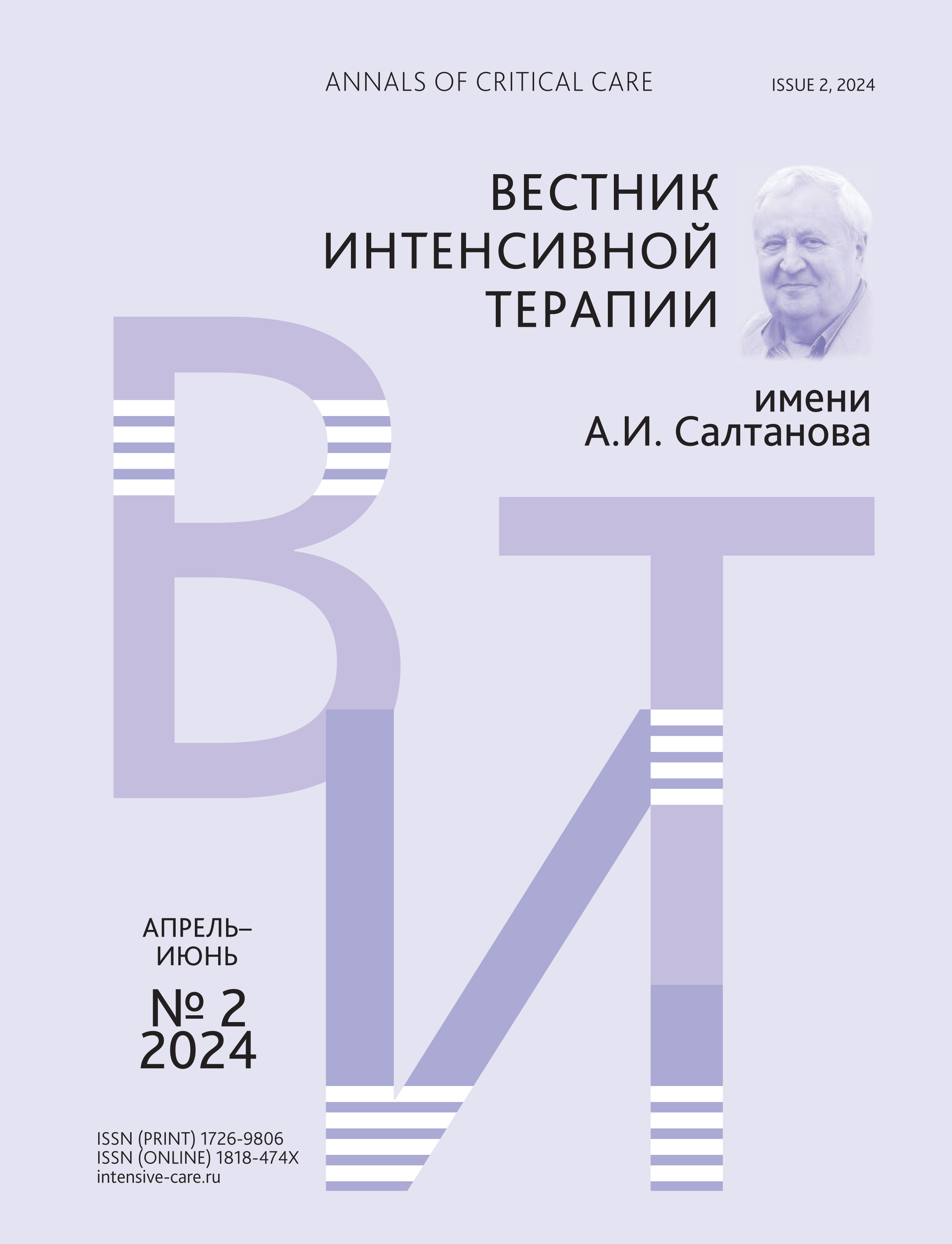Full-text of the article is available for this locale: Русский.
Abstract
INTRODUCTION: Multimodal analgesia is the main management strategy for postoperative pain. One component of this approach is opioid agonists. OBJECTIVE: Assessment of pain intensity profile after a single administration of the new selective µ1-opioid receptor agonist taphalgin in traumatology and orthopedic patients. MATERIALS AND METHODS: This prospective observational program analyzed data from 100 patients whom were prescribed the drug taphalgin for pain relief after traumatological and orthopedic surgery. All patients were treated with 50 mg dexketoprofen when moderate pain appeared after surgery. If the pain reached moderate or high intensity again, 4 mg of taphalgin was administered subcutaneously and then the change in pain intensity at rest and during movement was observed after 15, 30, 45, 60 min, as well as 2 and 4 h, using numerical rating scale (NRS). In this study physicians’ satisfaction by taphalgin was estimated. Satisfaction was assessed using Likert scale, where 1 — very bad, 2 — unsatisfactory, 3 — satisfactory, 4 — good, 5 — excellent. Repeated measures analysis of variance and dependent samples t-test were used for statistical analysis. The critical level of significance for accepting significant differences was set at 0.05. RESULTS: The average value of pain intensity before drug administration at rest was 5.9 ± 0.5 points and pain in movement was 8.4 ± 0.8 points. After just 15 min, significant pain reduction was achieved to 4.9 ± 0.8 and 7.3 ± 1.1 points (p < 0.001), respectively, after 30 min — to 3.6 ± 1.1 and 5.7 ± 1.1 points (p < 0.001), respectively, and after 60 min — to 2.2 ± 0.8 и 4.2 ± 0.8 points (p < 0.001), respectively. Doctor’s satisfaction with treatment showed that a positive assessment was given in 83 % of cases, and complete dissatisfaction was revealed in 1 % of cases. Impotently, no observations of respiratory depression or postoperative nausea and vomiting syndrome have been recorded. CONCLUSIONS: The drug taphalgin is an effective analgesic for the postoperative period in traumatology and orthopedics.
References
- Sandier A.N. Update on postoperative pain management. Mise à jour sur le traitement de la douleur postopératoire. Can J Anaesth. 1992; 39(Suppl 1): R53. DOI: 10.1007/BF03008843
- Kim C.H., Lefkowits C., Holschneider C., et al. Managing opioid use in the acute surgical setting: A society of gynecologic oncology clinical practice statement. Gynecol Oncol. 2020; 157(3): 563–9. DOI: 10.1016/j.ygyno.2020.01.024
- Joshi G.P. Rational Multimodal Analgesia for Perioperative Pain Management. Curr Pain Headache Rep. 2023; 27(8): 227–37. DOI: 10.1007/s11916-023-01137-y
- Васильев Я.И., Гриб П.А., Карелов А.Е. и др. Роль магния сульфата в предупреждении послеоперационного болевого синдрома. Анестезиология и реаниматология. 2022; 4: 71–7. DOI: 10.17116/anaesthesiology202204171 [Vasilyev Y.I., Grib P.A., Karelov A.E., et al. Magnesium sulfate for prevention of postoperative pain syndrome. Russian Journal of Anaesthesiology and Reanimatology or Anesthesiologiya and reanimatologiya. 2022; 4: 71–7. DOI: 10.17116/anaesthesiology202204171 (In Russ)]
- Карелов А.Е. Современные представления о механизмах боли. Анестезиология и реаниматология. 2020; 6: 88–95. DOI: 10.17116/anaesthesiology202006187 [Karelov A.E. Modern concepts of pain mechanisms. Russian Journal of Anaesthesiology and Reanimatology or Anesthesiologiya and reanimatologiya. 2020; 6: 88–95. DOI: 10.17116/anaesthesiology202006187 (In Russ)]
- Ochroch J., Usman A., Kiefer J., et al. Reducing Opioid Use in Patients Undergoing Cardiac Surgery — Preoperative, Intraoperative, and Critical Care Strategies. J Cardiothorac Vasc Anesth. 2021; 35(7): 2155–65. DOI: 10.1053/j.jvca.2020.09.103
- Nagappa M., Weingarten T.N., Montandon G., et al. Opioids, respiratory depression, and sleep-disordered breathing. Best Pract Res Clin Anaesthesiol. 2017; 31(4): 469–85. DOI: 10.1016/j.bpa.2017.05.004
- Shi S., Xu J., Feng L., et al. Novel µ opioid antagonists derived from the µ opioid agonists endomorphin and [Dmt1]DALDA (H-Dmt-D-Arg-Phe-Lys-NH2). Chem Biol Drug Des. 2020; 96(5): 1305–14. DOI: 10.1111/cbdd.13743
- Gerbershagen H.J., Aduckathil S., van Wijck A.J., et al. Pain intensity on the first day after surgery: a prospective cohort study comparing 179 surgical procedures. Anesthesiology. 2013; 118(4): 934–44. DOI: 10.1097/ALN.0b013e31828866b3
- Walker E.M.K, Bell M., Cook T.M., et al. Patient reported outcome of adult perioperative anaesthesia in the United Kingdom: a cross-sectional observational study. Br J Anaesth. 2016; 117(6): 758–66. DOI: 10.1093/bja/aew381
- Овечкин А.М., Баялиева А.Ж., Ежевская А.А. и др. Послеоперационное обезболивание. Клинические рекомендации. Вестник интенсивной терапии им. А.И. Салтанова. 2019; 4: 9–33. DOI: 10.21320/1818-474X-2019-4-9-33 [Ovechkin A.M., Bayalieva A.Z., Ezhevskaya A.A., et al. Postoperative analgesia. Guidelines. Annals of Critical Care. 2019; 4: 9–33. DOI: 10.21320/1818-474X-2019-4-9-33 (In Russ)]
- Hofstad J.K., Klaksvik J., Wik T.S. Intraoperatively local infiltration anesthesia in hemiarthroplasty patients reduces the needs of opioids: a randomized, double-blind, placebo-controlled trial with 96 patients in a fast-track hip fracture setting. Acta Orthop. 2022; 93: 111–16. DOI: 10.2340/17453674.2021.806
- Buvanendran A., Fiala J., Patel K.A., et al. The Incidence and Severity of Postoperative Pain following Inpatient Surgery. Pain Med. 2015; 16(12): 2277–83. DOI: 10.1111/pme.12751
- Карелов А.Е., Косоруков В.С., Краевская Ю.Н. и др. Эффективность нового пептидного анальгетика тафалгина в лечении послеоперационной боли. Анестезиология и реаниматология. 2023; 6: 75–83. DOI: 10.17116/anaesthesiology202306175 [Karelov A.E., Kosorukov V.S., Kraevskaya Y.N., et al. Effectiveness of the new peptide analgesic Tafalgin in the treatment of postoperative pain. Russian Journal of Anesthesiology and Reanimatology. 2023; 6: 75–83. DOI: 10.17116/anaesthesiology202306175 (In Russ)]

This work is licensed under a Creative Commons Attribution-NonCommercial-ShareAlike 4.0 International License.
Copyright (c) 2024 Annals of Critical Care

